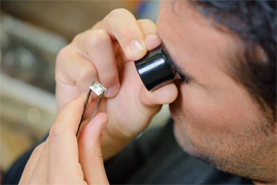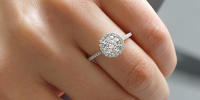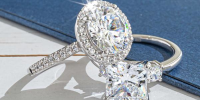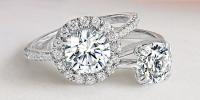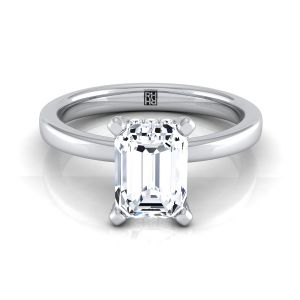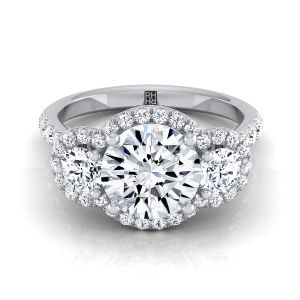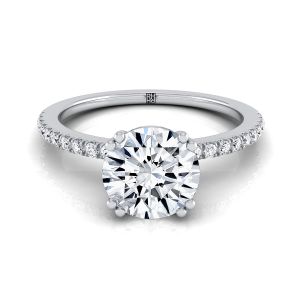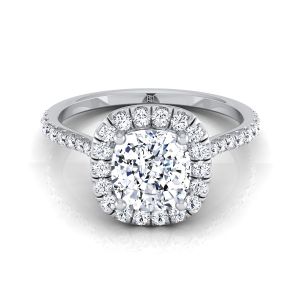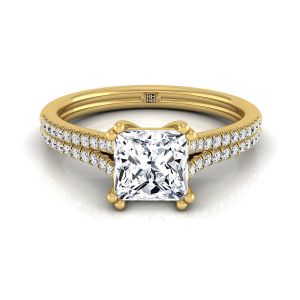Shop Lab Created Diamonds When you compare lab grown diamonds vs natural diamonds, the difference isn't in the way they look. Lab grown diamonds are composed of crystallized carbon just like natural diamonds so the two have the same appearance and the same physical, chemical and optical characteristics. But lab-grown diamonds are manufactured by man, they didn’t form naturally in the earth. And that difference is important: here’s why. Lab-grown diamonds are less rare than natural diamonds, so they cost much less.
How Natural Diamonds Form
 The journey of natural diamonds to your finger is long and difficult. Natural diamonds formed billions of years ago deep in the earth under tremendous heat and pressure. They traveled to the earth’s surface in volcanic pipes, ascending a hundred miles in a column of molten rock, more than three times the depth of the average volcano.
So many factors had to align just perfectly for diamonds to form in the ancient earth and be carried up to the surface. Those conditions no longer exist: all the diamonds the earth will form already exist. These almost indestructible gems survived their journey remarkably unscathed. Inside they carry tiny time capsules of the earth’s crust a billion years ago: crystals from the deep earth, tiny cleavages from the pressure, and atoms from the mantle that came along for the ride. These brilliant billion-year-old crystals are the oldest thing you will ever touch.
Because their journey is so difficult, the vast majority of diamonds found are not gem quality. This rarity is why real diamonds have significant inherent value, which will continue to increase as the number of diamonds naturally available gets lower and lower. All the gem-quality diamonds ever mined would fit in one London double-decker bus. Diamonds are really rare.
Diamond comes from the ancient Greek adamas, meaning unbreakable. The extreme
pressure and heat a diamond endures for billions of years to come out looking so
beautiful is a truly incredible thing.
The journey of natural diamonds to your finger is long and difficult. Natural diamonds formed billions of years ago deep in the earth under tremendous heat and pressure. They traveled to the earth’s surface in volcanic pipes, ascending a hundred miles in a column of molten rock, more than three times the depth of the average volcano.
So many factors had to align just perfectly for diamonds to form in the ancient earth and be carried up to the surface. Those conditions no longer exist: all the diamonds the earth will form already exist. These almost indestructible gems survived their journey remarkably unscathed. Inside they carry tiny time capsules of the earth’s crust a billion years ago: crystals from the deep earth, tiny cleavages from the pressure, and atoms from the mantle that came along for the ride. These brilliant billion-year-old crystals are the oldest thing you will ever touch.
Because their journey is so difficult, the vast majority of diamonds found are not gem quality. This rarity is why real diamonds have significant inherent value, which will continue to increase as the number of diamonds naturally available gets lower and lower. All the gem-quality diamonds ever mined would fit in one London double-decker bus. Diamonds are really rare.
Diamond comes from the ancient Greek adamas, meaning unbreakable. The extreme
pressure and heat a diamond endures for billions of years to come out looking so
beautiful is a truly incredible thing.
How Lab-Grown Diamonds Are Manufactured
Diamonds have been manufactured by man for decades but only in the past five years have they been practical to market in jewelry. Until then, most diamonds were manufactured for industrial use and didn’t have the size, clarity, or affordability that would make them attractive for jewelry use. Synthetic diamonds are manufactured one of two ways: HPHT (high pressure, high temperature) or CVD (chemical vapor deposition). HPHT uses extreme temperature and pressure to mimic the environment within the earth that naturally creates diamonds. CVD feeds energized gasses onto a substrate in a vacuum chamber similar to a microwave. Marketers say that these stones are “grown” in a “laboratory” but it’s probably more accurate to say they are precision manufactured in a high tech factory. One single diamond-producing factory in Singapore is 200,000 square feet: it produces 300,000 carats of lab-grown diamonds every year. Diamonds crystals form in these controlled conditions in a few weeks. Inside they show evidence of the factory conditions under which they formed. Lab-grown diamonds display visual characteristics such as color zoning, metallic inclusions, weak strain patterns, and colors of ultraviolet fluorescence. After the rough is made, lab-grown diamonds are cut and polished in the same way that natural diamonds are. However because lab-grown diamonds are not rigorously graded for a cut like natural diamonds are, they generally aren’t cut to the same standards and proportions for maximum light performance.How You Can Tell the Difference
 The differences in the way natural diamonds and lab-grown diamonds form create the characteristics that gemologists use to tell them apart. You won't be able to tell just by looking at a stone in a ring.
Advanced testing equipment can confirm the identity of most natural diamonds automatically. A few will be referred for advanced testing. Diamond grading laboratories can identify 100% of lab grown diamonds. Labs generally engrave the girdle of lab-grown diamonds with the words “laboratory grown” to make sure that buyers know what they are getting.
That’s another reason why it’s important to only buy natural diamonds that have a grading report from a respected independent laboratory like GIA that confirms their origin.
The differences in the way natural diamonds and lab-grown diamonds form create the characteristics that gemologists use to tell them apart. You won't be able to tell just by looking at a stone in a ring.
Advanced testing equipment can confirm the identity of most natural diamonds automatically. A few will be referred for advanced testing. Diamond grading laboratories can identify 100% of lab grown diamonds. Labs generally engrave the girdle of lab-grown diamonds with the words “laboratory grown” to make sure that buyers know what they are getting.
That’s another reason why it’s important to only buy natural diamonds that have a grading report from a respected independent laboratory like GIA that confirms their origin.
Lab-Grown Diamonds, Prices, and Value
Of course, there’s another difference between natural diamonds and lab-grown diamonds: price and value. Although lab-grown diamonds cost less than natural diamonds, they may not hold their value like natural diamonds do. Laboratory-grown diamonds don’t have enough of a track record to determine what consumers are willing to consistently pay for them. There isn’t a secondary market yet for lab-grown diamonds since there is so much uncertainty about them holding value. Lab grown diamonds are much more affordable today than five years ago. We’re not sure if lab-grown diamond prices will continue to fall or even drop dramatically. It's likely that laboratory-grown diamond production will continue to get cheaper and cheaper as competition grows, forcing producers to keep lowering their sales price for these stones.Why We Were Skeptical
Because we come from generations of diamond professionals, we’ve always taken the long view of fine jewelry. We believe in quality and value and crafting jewelry that will become family heirlooms over generations. We’re also very conscious of the meaning that jewelry holds, how it represents love, carries family traditions, and celebrates meaningful moments of life. That’s why we decided not to carry lab-grown diamonds. Were they worthy of the special moments of our customers’ lives? Would they be something they could be proud of forever? We weren’t sure. We’re also aware of the communities that depend on diamonds around the world. That’s why we were among the first jewelers to offer diamonds that can be traced back to their source countries. Natural diamonds help support 10 million people globally. Diamond revenues give every child in Botswana, the second largest diamond producing country in the world, a free education. For every acre mined, De Beers donates five acres for conservation. This is just a small portion of the good that is being done in the diamond industry.How You Changed Our Minds
Because our skepticism about lab grown diamonds was based on our worries about whether we would be offering real value, we began asking our customers what they thought about lab-grown diamonds. Would they be proud to wear one as an engagement ring even if we couldn’t guarantee long-lasting value? Many of our customers said yes. They were impressed by the innovation that man-made diamonds represent. They felt that although creating lab-grown diamonds requires energy, they felt better knowing that they aren’t mined. And they welcomed the fact that they could afford a bigger, better quality diamond for the same price, even if the resale value someday might not be as high. Ultimately, for all these reasons, we decided to listen to our customers and offer lab-grown diamonds in all our engagement rings and other jewelry designs. We’re embracing a new fifth C: choice. We’re especially excited about our new lab-grown diamond engagement ring selection. We’ve curated a selection of exceptional certified lab-grown diamonds, so you don’t have to compromise on quality. And we’ve created a great new selection of perfectly matched lab-grown diamond stud earrings so you can upgrade to the studs you’ve always wanted. You can choose lab-grown in all our handcrafted custom jewelry designs too. We’re still huge fans of natural diamonds. We believe that the value of diamonds comes from their powerful symbolism as a rare gift from the earth. We wear diamonds because of what they mean, not how they look. It is because of a diamond's unbreakable spirit they have come to be the ultimate representation of love, commitment, and achievement against the odds and a legacy that lasts generation after generation. But wearing lab grown diamonds can also be a story of human ingenuity, progress, and respect for the planet. Lab-grown diamonds look forward instead of back. You can write the story of the future of diamonds. We can’t wait to see what you’ll create. Shop Lab Created Diamonds









